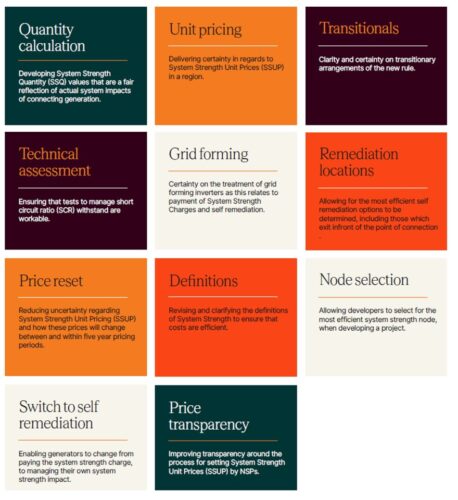It’s good advice to anyone involved in the energy industry, a sector that sometimes feels like early Tarantino, there are so many lustrous projectiles in flight.
From ahead markets through locational marginal pricing and capacity markets, there are no shortage of parties spruiking elegant ammunition to solve all your problems (guaranteed).
It’s telling that most of those argentium slugs have not yet found their mark – or have been quietly decommissioned. Instead, real and effective reform focuses on empirical evidence and targeted change that work together, to deliver actual benefit.
This is what the Clean Energy Council has done in regards to system strength. Our members told us the System Strength frameworks weren’t working. Our own analysis confirmed it. So, we sat down with industry, governments and regulators to try to find a better way of doing things.
We’ve made 15 recommendations for targeted change. In tandem, we’re confident these incremental changes will deliver better outcomes.
System strength is a complex beast. Broadly speaking, it refers to a number of power system characteristics that must be very carefully coordinated, to ensure the system stays stable and to allow renewables to stay connected. It’s a phenomenon that has arisen as the power system transitions from coal to renewables.
Many people have been working for many years trying to understand the technical challenges of system strength and to figure out regulatory frameworks to address them. The Australian Energy Market Commission had two goes at developing these frameworks, and the Australian Energy Regulator and Australian Energy Market Operator have also been extensively involved.
The theory behind the System Strength frameworks is to deliver this essential system service at a lower cost, by taking advantage of economies of scale and scope. Put simply, the idea was that by making network companies provide large centralised system strength solutions, ahead of when it were needed, total costs would be minimised.
The challenge with designing new regulations during periods of rapid change is that sometimes the technology outpaces the rules.
By the time it came to implement the system strength frameworks, many of the Clean Energy Councils’ members were finding that practice didn’t line up with theory. Scale economies weren’t being achieved and there was a real risk the scheme might not meet its original objectives of keeping costs down for generators and customers.
So, we engaged with many different people, to try and understand these technical, commercial and economic problems. At its core, the issue was that system strength was costing too much. This is of course a problem for renewable generators, who have to pay some of the cost of system strength. But it’s also a problem for customers, who share the rest of these costs.
In the longer term the problems we found with the System Strength frameworks were delaying investment, which eventually would translate to higher electricity costs and maybe even supply shortfalls.
Our report identifies 11 issue areas with the existing System Strength frameworks and makes 15 recommendations to resolve them. There’s a lot of technical detail to get across but here are some of the key problems and solutions our report sets out.

At the moment, when a renewable generator connects to the system, the generator decides to either pay to use system strength provided by the network company, or to bring its own. This is a commercial decision; the generator will go with the cheaper option. This is a good thing, as it puts some competitive discipline on the network companies to keep their prices down.
The network company determines a price for the system strength it sells to generators. This price is fixed for five years – at the end of this period, the network can adjust the price either up or down.
The original thinking was that as new technologies became available, system strength costs would inevitably decline. Generators need to be confident this will happen. Renewable assets have operating lives of at least 20 years, so renewable investors need to be confident the price they pay for System Strength in year one will not markedly increase out to year 20.
The problem is that System Strength prices have shown significant volatility across the East Coast of Australia. Coupled with supply chain constraints, many investors are concerned the System Strength price they agree in year 1 will increase significantly at year 5, and then again in years 10 and 15. By then, they are locked in and stuck paying the charge – it’s too late, or too expensive, to make the decision to bring their own system strength instead.
Many investors consider this a major downside risk. It either increases their investment cost, which is ultimately passed through to consumers, or it just means they end up building their own system strength solution, which entirely defeats the purpose of the whole scheme.
The Clean Energy Council recommends this be resolved by imposing a cap on any changes in the system strength price, between five year periods. This will give investors greater confidence that system strength charges will be stable, reducing investment costs and keeping costs down for consumers.
Unit pricing
Another issue is that the System Strength prices determined within and between different States have shown some pretty significant variations. This creates confusion for renewable investors and runs contrary to the idea of sending clear and understandable locational signals.
Engaging with network companies, we also learned there was confusion as to how they were supposed to calculate these prices, which may have given rise to the significant variation.
To address this, we’ve proposed a limit placed on the allowed difference between the System Strength prices that can occur in any given State. We also recommended that if a network company can find a way to deliver system strength at a lower cost, they should have the freedom to adjust their prices halfway through a 5 yearly pricing period.
We also recommended there be greater guidance provided to network businesses about how they should calculate these prices, to get more consistency across states.
Grid forming capability
Another issue was that the technological capabilities of renewable generators and batteries have not yet been properly recognised in the System Strength frameworks.
In particular, Grid Forming capability has the potential to provide System Strength at a markedly lower cost than some of the more traditional solutions the original frameworks were designed around.
The Clean Energy Council recommends that AEMO provide further detail as to how this remarkable new technology should be treated. In particular, clear rules need to be developed so that everybody understands the contribution to System Strength provided by this technology.
System strength definitions
Finally, the Clean Energy Council considers the very definition of System Strength needs to be reassessed.
While AEMO has done some great work in defining System Strength, more remains to be done. In particular, we must recognise the changing needs of the power system and make sure the System Strength frameworks are delivering what’s needed, at the lowest possible cost to generators and consumers.
If you got this far you’re either thoroughly confused, or deeply frustrated at the lack of technical detail provided. In either case – please read the report! It’s written in a way that is meant to be accessible to any reader, with additional detail provided for those of you who feel you need it.
For us, next steps are to work closely with the market bodies and governments to continue the process of fixing these System Strength frameworks. These frameworks are the backbone of the transition. It’s imperative that we all work together, patiently and collaboratively, to get them right.
Christiaan Zuur is Policy Director of Market, Investment and Grid with the Clean Energy Council.









